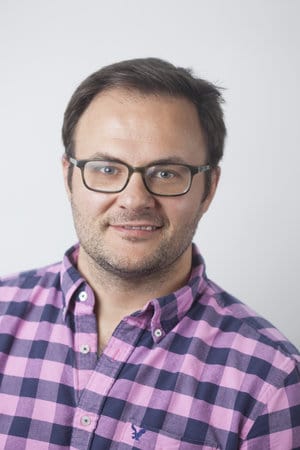Trust, Not Peer Pressure: Adapting the Global Microfinance Model for the U.S.
In his nearly ten years working as a program director at Whole Foods’ Whole Planet Foundation, Steve Wanta got a crash course in the global microfinance model. He oversaw a team of international development professionals who traveled the world, seeking out leading microfinance institutions and authorizing $70 million in funding to MFIs in 70 countries.
The work gave him a unique perspective on the strengths and weaknesses of microfinance as it’s practiced in emerging markets. He has leveraged these insights in his current work leading JUST, an Austin-based nonprofit that invests in low-income female entrepreneurs — starting with Hispanic women in Texas — to help them improve their lives and communities.
We spoke with Wanta via email about JUST’s work, and the unique spin it’s putting on the well-worn microfinance model. Check out our interview below.
James Militzer: Before starting JUST, you’d worked as Executive Program Director at Whole Foods Market’s foundation, Whole Planet. What did that experience teach you about how to design sustainable and impactful microfinance projects?
Steve Wanta: Everything. The backstory of Whole Planet Foundation is known by few and offers important context for why I started JUST.
In 2004, John Mackey, co-founder and CEO of Whole Foods Market, decided it was time for the company to explore ways to give back to the global communities with which it traded. Until that point, their philanthropic efforts had primarily been invested in local communities around their grocery stores in the United States.
John learned about microfinance and began to investigate how the company could create a compelling social impact program. Along the way, he met Professor (Muhammad) Yunus. Yunus had won the Nobel Peace Prize two years earlier. Mackey and Professor Yunus decided they could do something special together: The Grameen Bank would provide the human capital, and Whole Foods’ newly formed foundation, Whole Planet, would provide the financial capital. In 2006, they decided to create new MFIs in Guatemala and Costa Rica. They sent two teams of five Grameen Bank experts from Bangladesh to build and operate the new organizations.
Yes, you read this correctly. A grocery store funded the creation of two Central American microfinance institutions staffed by 10 Bangladeshis who did not speak Spanish.
Very quickly, the Executive Director of Whole Planet Foundation saw that the teams needed more hands-on support. I was hired to be the resident “fixer” in Central America. For the better part of two years, I traveled back and forth to Guatemala and Costa Rica to help buy motorcycles, hire staff and deal with an array of administrative challenges.
Remarkably, despite the cultural and language barriers, the Grameen teams were able to lend money and be repaid with extreme efficiency. It gave me a front row seat into building a new microfinance institution (MFI) from the ground up. I witnessed all of the little things that made Grameen, Grameen.
This experience became the basis for Whole Planet Foundation’s programmatic strategy. For ten years, I oversaw a small team of international development professionals who traveled the world finding and funding the world’s greatest MFIs. We sought out organizations that utilized a process to mitigate risk, rather than using financial and legal barriers to exclude microentrepreneurs. At the end of my tenure in 2016, we had authorized $70 million in funding to MFIs in 70 countries.
My ten years with Whole Planet Foundation taught me the nuanced nature of impact and sustainability. I believe there are opportunities, especially in the United States, for new measures of impact and sustainability.
JM: Where is JUST currently working, and what does your typical client profile look like?
SW: JUST operates exclusively in Central Texas and is currently expanding operations into North Texas. We launched with a focus on Hispanic female entrepreneurs because we knew the traditional group lending approach could work. We were and continue to be committed to co-creating a new way with the community we serve. Since our pilot, we have developed a compelling, holistic program that we have translated from Spanish into English, that we are beginning to introduce to non-Spanish speaking female entrepreneurs.
JM: Briefly describe JUST’s mission and approach – how does it differ from typical lenders, especially in regard to the usage of trust vs. credit scores/collateral?
SW: JUST invests in low-income female entrepreneurs to create more resilient communities, starting in Texas. We provide capital, coaching and community through a network of trust agents that we call JETAs (JUST Entrepreneur Trust Agents). JUST’s mission is to create new, more and better opportunities for our entrepreneurs to succeed. Beyond credit for business, our higher purpose is building a more just world where people can live with less stress and more joy.
Unlike traditional lenders in the United States, we do not use credit scores, collateral or complicated paperwork to approve entrepreneurs for our program. Our credit underwriting is a process. If someone completes the process, 100 percent of the time, she gains access to our capital, only one part of a complete program.
JM: What have been the main challenges in applying the global microfinance model to U.S. entrepreneurs?
SW: The biggest issue we have faced is one of perception. People either do not know or do not understand what microfinance is, how it works or why it matters for the United States. In fact, there is a lack of awareness of the barriers entrepreneurs face in the U.S.
At the very first stage of launching JUST, the most difficult aspect was finding clients. The United States does not have natural community meeting spaces like in rural Guatemala. Once we found our first clients, many more came calling. We are really excited by some of the new partnerships we are developing to reach more entrepreneurs, more quickly.
I still think the hardest challenges are ahead of us. Currently we have a little over 300 active clients and have lent over $1.3 million with a 99 percent repayment rate. Yet our vision is to serve hundreds of thousands of deserving entrepreneurs, which requires much more institutional capacity on all fronts.
JM: You’ve written that “the initial mission of microfinance was to alleviate the suffering of the poor. Over time, the industry became more and more fixated on the transaction of credit as a means to scale.” Why do you think that has happened? Can you offer an example or anecdote that illustrates how this “fixation on the transaction of credit” has changed the experience/impact of microfinance for poor clients?
SW: For a long time, the microfinance industry tried to answer the question of how to scale. It was generally accepted that loans disbursed, along with high repayment, proved that microfinance worked. The poor must be better off. No longer were people destitute: They became partners in the mission to create a better world for all.

Steve Wanta, CEO and Co-Founder of JUST
In my opinion, the need for profits drove the industry up market, away from its original grassroots ideals.
So, with this powerful and beautiful narrative, the mission was clear. How do we serve as many people as possible, as quickly as possible? New forms of capital entered the sector, and new narratives emerged. Compartamos and SKS are the poster children for this new microfinance. The industry then shifted language away from the lofty goals of ending poverty to a more attainable goal of financial inclusion.
These organizations and this shift are not inherently good or bad; it is simply an evolution. These changes are contrary to the reason I got into the field. I came to realize that even traditional group lending is designed to protect the credit, not necessarily to meet the needs of the individual borrower. It is designed to efficiently scale with low defaults to achieve financial sustainability. The big question is how to do both: help the individual and scale to serve millions?
I think the greatest impact microfinance has had on the poor has been in proving that they are a deserving market. Social enterprises like One Acre Fund and Babban Gona in Nigeria are building on the decades of microfinance experience to create new models of impact for the world’s poorest, utilizing credit as one component of a holistic program.
JM: You’ve also written that in typical microfinance, “More often than not, peer pressure is used to ensure repayment rather than using community as a social safety-net when times are tough.” Yet as I understand it, JUST also leverages the influence of peers (what you term “peer support”) to encourage loan repayment. How would you characterize the difference between “peer support” and “peer pressure,” and can they be equally effective?
SW: Good delinquency management happens before loans are ever made. There is an art and science to using social capital without collateral or forced savings to ensure repayment. We refer to it as intentional friction. We need all of our entrepreneurs to enter our program with eyes wide open, and to opt out if it is not for them.
Where JUST has created a significant innovation is on tripling down on the upfront investment. Our JETAs complete an 8-week leadership training program that is designed to give them confidence to facilitate small group conversations. JETAs are truly empowered to choose their own small support group of other entrepreneurs whom they trust. And that is the beauty of microfinance. The structure (small loans, frequent repayments, income generating, etc.) is designed such that anyone can successfully repay.
The JUST model has reduced the reliance on peer pressure because our groups are small. In many parts of the world, borrowing groups can include 50 women or more. At a minimum, groups I knew were usually 20 to 30 women. The larger the group, the looser the connections are, and thus the need for pressure. Think about your family for a second. If your sister was in trouble, you would likely be eager to help. Now imagine your third cousin – do you even know his name?
JUST groups are as small as three and no larger than 10. In the event someone stumbles, we absolutely expect the JETA to help. Our community wants each person to succeed. One of our major insights in focusing on peer support was the discovery that there are only three reasons why an entrepreneur will not repay:
First, their business fails. Second, they have an emergency. Third, they are gaming the system because it is (relatively) easy money. We absolutely do not accept that someone games the JUST system. We created simple rules to help entrepreneurs improve their businesses. And finally, we have introduced creative ways to inspire people to save and prepare for the next emergency.
All of our efforts are directed toward helping our community succeed. If we do that well, extremely high repayment percentages will be a natural byproduct.
JM: How time-intensive is the process of establishing client trust to enable lending, and is that a barrier to scale?
SW: Trust is a two-way street. A traditional lender holds all of the power. The lender decides, analyzes, rejects or approves. Does this resemble trust?
With JUST, we establish extremely clear rules and steps that guide our program. When entrepreneurs complete the process, 100 percent of the time they receive our loan. Up to $5,000 in our process is based exclusively on trust; no credit check, no collateral. It requires a total of 3 hours for a new client, invited by a JETA, to receive their first loan. That is when the “Trust Train” leaves the station. During those three hours, we clearly detail the expectations and help them to see how they are now becoming part of something much bigger.
True trust and meaningful scale are built over time.
JM: You’ve said you believe JUST can be “the most efficient microfinance institution in the world.” What’s the basis for this bold goal?
SW: One of the major metrics of efficiency in microfinance is the credit officer to borrower ratio. Two hundred to 300 clients to one credit officer is doing really well. We think we can reach 1,000+ clients per Community Director (credit officer) because of the process innovations we have created – a JETA-led, technology-enabled, human-centered approach.
These process innovations have led us to create and manage a team of Community Directors differently from traditional microfinance. Normally, a credit officer has a finite number of clients he or she can serve. It is a hierarchical system; we are attempting to introduce a distributed trust network. Instead, JUST Community Directors lead a particular area of focus, like JETA training or entrepreneur support. They collaboratively work on other functions, like collections, as a team. This has created a more flexible and resilient model for managing our human resources. This is central to our strategy of creating the smallest and most sustainable unit possible.
JM: What are JUST’s plans for the future – will you expand beyond your current base in Texas to other U.S. states, or even abroad? Are there any barriers to that happening?
SW: We are in the process of expanding into North Texas to demonstrate we can do this work at scale. Like traditional microfinance, we do believe scale is important. We believe that if we have found part of the solution to unlocking opportunity, we have a responsibility to serve as many people as possible.
Through 2021, we are committed to proving JUST’s capacity to efficiently, effectively and sustainably serve two markets in Texas. After that time, we will be open to potential expansion into other geographic areas.
The biggest barrier to serving hundreds of thousands of low-income entrepreneurs is money. Like global microfinance, we believe our profitability will help address this challenge. Unlike traditional microfinance that focuses exclusively on credit, JUST will offer other non-credit products that help our entrepreneurs succeed. We believe that by introducing other revenue sources, we can align our organization’s need for profitability with our higher purpose of creating less stress and more joy.
James Militzer is an editor at NextBillion.
Image courtesy of JUST.
- Categories
- Uncategorized



